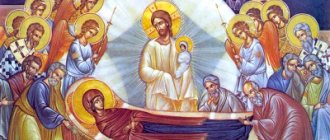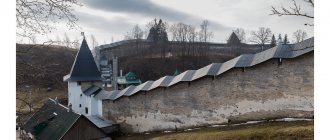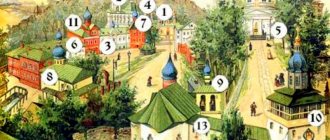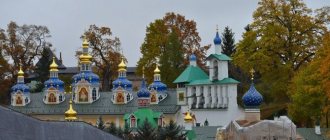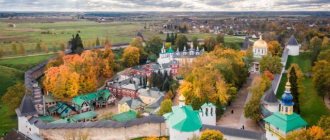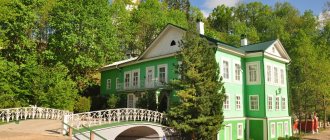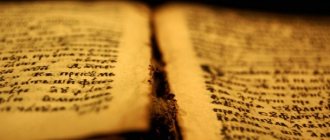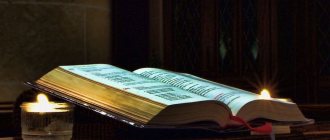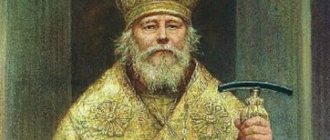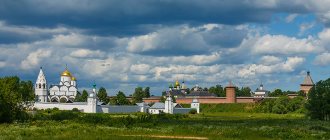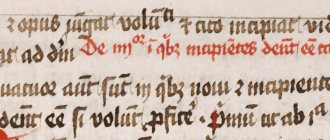What is a requirement?
Treba is a sacred rite performed by a clergyman at the request (at the request) of a believer, for himself or his loved ones. This is your request to the Lord, with which the clergy turn to him together with you.
In our sincere desire to help you, we are extremely pleased to invite you to take advantage of the capabilities of the communication stand of our resource “ Order Requirements
" From home in the most comfortable mode, you can order services in the church, services or commemoration at the Divine Liturgy within forty days - Sorokoust
.
Cost required
The cost of holding religious services (services) in each church is set individually. For this reason, you need to choose the best temple or monastery for yourself that is suitable for your price. In most churches and monasteries, the cost of holding services is affordable for almost any person, so the choice of a temple for holding services should first of all be determined by where your soul asks.
It is important to understand that churches do not have such a thing as “cost of service” or “price for holding a service.” The money that the temple accepts should be perceived by parishioners solely as a voluntary donation. The temple only guides parishioners by informing them of the minimum donation amount. The actual amount of donation for the service is determined by the parishioner at his own discretion.
Requirements are free
In special cases, which are considered individually, the temple can hold the service for free, but these are truly exceptional cases that are best not to be abused.
Important to remember!
In prayers for health and repose , only those baptized in the Orthodox Church are remembered.
Ask the Lord for help in your affairs and endeavors. Use the service of our website and order an online prayer service at the monastery for any of your needs. You will be heard. God bless you!
Assumption Pskovo-Pechersky Monastery in the city of Pechery, Pskov region
Presumably of natural origin, erosion-suffosion caves in sandstone deposits along the banks of the Kamenets stream became known to local residents in 1392. According to legend, they were inhabited by monks who fled to the Pskov land from the south, from the raids of the Crimean Tatars. The main cave complex is called “God-created cave”, and consists of the Assumption Cave Church with a bypass gallery (small caves), nearby caves with the relics of the Venerable Pechersk Mark (“the initial monk”), Jonah, Lazarus and mother Vassa, and then continues with a necropolis of seven underground gallery-streets with the cave Church of the Resurrection of Christ at the end of the 6th gallery and a chapel. According to legend, the caves were rediscovered by Ivan Dementev around 1470, already with an inscription above the entrance “God-created cave.” In 1470, Hieromonk Jonah, a former priest of the St. George Church of Yuriev-Livonsky (now Tartu), settled in the cave, who excavated the cave where he built Church of the Assumption of the Blessed Virgin Mary, consecrated in 1473. A monastery was subsequently formed around the temple. Located on the border between Russia and Livonia, where the Germans ruled, the monastery was more than once subjected to destruction by the Germans, Swedes and Poles. The Moscow government, due to the important military situation of the monastery, strengthened it with fortress walls. In the Assumption Church, in a copper shrine, the relics of St. Cornelius, one of the first abbots of the monastery, died a martyr at the hands of Ivan the Terrible, who suspected the abbot of treason. The sacristy housed many ancient jewels and relics. The library was rich in old printed books and manuscripts. After the occupation, the Pskov-Pechersk Monastery continued to remain under dual subordination: Metropolitan Alexander (Paulus) of Tallinn and Metropolitan Sergius (Voskresensky), Exarch of the Baltic States. From 1940 until October 1941, the abbot of the monastery was Archimandrite Parfeniy (Shatinin). In October 1941, Parfeniy (Shatinin) retired due to old age and, by decision of the elders, Abbot Pavel (Gorshkov), who ran the monastery until his arrest by the Soviet secret services at the end of 1944, took over the leadership. On January 16, 1945, the Pechora region was transferred from the Estonian SSR to the Pskov region of the RSFSR. For about 40 years, only two monasteries operated on the territory of the Russian Federation - the Pskov-Pechersk Monastery and the Trinity Lavra of St. Sergius, opened in 1946. In order to assure the surrounding population of “freedom of conscience in the USSR,” the Council for the Affairs of the Russian Orthodox Church organized a visit to the monastery by Patriarch Alexy (Simansky) in the summer of 1946. From 1949 to 1954, the governor was Archimandrite Pimen (Izvekov), later the Patriarch of Moscow and All Rus'. On July 28, 1959, by the Decree of His Holiness Patriarch Alexy, Abbot Alipiy (Voronov) was appointed vicar (in 1961 he was elevated to the rank of archimandrite), who worked diligently until March 12, 1975 in the restoration and preservation of the Pskov-Pechersk monastery. Alypiy did not allow the monastery to be closed during the difficult years of Khrushchev’s “thaw” for the church; thanks to his efforts, in 1973, treasures taken by the Nazis from the monastery’s sacristy were returned to Pechory. Metropolitan Veniamin (Fedchenkov), Archbishop Vladimir (Kobets), Bishops Theodor (Tekuchev), Ioannikiy (Speransky), Andrey (Sukhenko) spent the last years of their lives in the monastery. All of them are buried in the monastery caves. In September 1995, Archimandrite Roman (Zherebtsov) of the Pskov-Pechersky Monastery, at the request of the Patriarch of Moscow and All Rus' Alexy II, resigned. He was accused by the press of having installed a coffin in the monastery caves with the body of Nikolai Gavrilenkov, one of the leaders of the Velikolukskaya organized crime group, who was killed on June 30, 1995. In the spring of 1942, Schemabishop Macarius (Vasiliev), who had previously been in an “illegal position” (catacomb bishop), settled in the monastery. The monastery took an active part in the activities of the Pskov Orthodox mission, outwardly showing loyalty to the occupation authorities in order to be able to serve legally. During the years of occupation, the Pskov-Pechersky Monastery hosted congresses and meetings of the highest clergy of the Baltic Exarchate, in particular the so-called archpastoral meeting, held on August 28, 1943 in the Sretensky Church, which was attended by: Metropolitan of Vilna and Lithuania Sergius (Voskresensky), Exarch of Latvia and Estonia, Archbishop of Narva Pavel (Dmitrovsky), Bishop of Riga John (Garklavs), Bishop of Koven Daniel (Yuzviuk), Schemabishop Macarius (Vasiliev) and others. The monastic brethren were represented by abbot Pavel (Gorshkov), monks Ilya, Arkady, Nikon, and schema-monk Simeon. On behalf of the occupation authorities, the Gebietskommissar, the mayor of the city of Petseri, and the prefect of police were present. In May 1943, A.A. visited the Pskov-Pechersky Monastery and spoke to the monks. Vlasov. On the night of March 31 to April 1, 1944, during a Soviet air raid in the monastery, Schebishop Macarius was killed by a bomb fragment. After the liberation of the Pskov region, Abbot Pavel (Gorshkov) was included in the commission to investigate the crimes of the occupiers in the Pskov region. But in October 1944 an unexpected arrest followed. He was accused of collaborating with the occupiers. Sentenced to 15 years for anti-Soviet activities. Died in 1950. Rehabilitated in 1997.
What requirements do you order on our website?
There are a great many situations when believers need the Lord’s help. Well aware of the needs that parishioners have, the Church has created a number of church rites that make it possible to make a request to the Creator through the clergy:
- Church commemoration. Having decided to order a commemoration online, you can submit petitions for health or repose, which are read out at the Liturgy for the eternal good or salvation of God.
- Prayer service. When holding a prayer service, they make requests to God, the Mother of God and the Saints for mercy, forgiveness, grace, gratitude or help in worldly affairs.
- The never-ending psalter. A prayer of high miraculous power is read continuously in monasteries and helps to spiritually cleanse and become closer to the Creator.
- Memorial service. The service is held for the deceased with a request to grant him peace and bestow the grace of eternal life.
- Sorokoust. If you want to order a magpie in a monastery via the Internet, then using our website you can count on enhanced prayer for repose or health during 40 Liturgies.
We will help you place a candle on the main altar or in front of the desired icon, and we will also make sure that your request is fulfilled, no matter how far you are from the chosen temple.
Pskov-Pechersk ascetics of piety, St. Jonah, St. Cornelius, St. Lazarus the Seer is glorified among the saints for his labors in the monastic life, for the numerous deeds and miracles shown by the saints.
In the Pskov-Pechersk Monastery they turn to the saints for intercession and prayers:
About help and consolation in sorrows;
About instruction and admonition;
About finding peace of mind;
About improving the lives of family and friends;
They ask for prayers for the forgiveness of sins;
About the granting of healings from illnesses and much more.
Pechora Fortress in Pskov: the story of a miracle
The founding date of the Pskov Pechora fortress is considered to be 1472, when the fugitive presbyter who became the founder of the stronghold, John, settled in a cave on the slope of the Kamenets River. A niche dug in sandy soil marked the beginning of the settlement and became known as the Church of the Assumption of the Blessed Virgin Mary. Under the next head of the monastery, Hieromonk Misail, cells for the inhabitants and a temple were built on a hill above the caves.
However, soon the Livonians plundered and burned the monastery
The history of the Pechersk Monastery is directly connected with the Russian tsars
After the Pskov Republic fell under the rule of Moscow in the early 16th century, the Tsar ordered the construction of fortifications, the construction of a temple and the renovation of cells in the monastery. The very first Assumption Church was surrounded by a façade, and the caves in the mountainside that served as the burial place for the monks were expanded and deepened.
The heyday of the monastery is considered to be the mid-16th century, when Ivan the Terrible turned his highest attention to it and ordered the construction of new fortifications of the monastery
The construction was supervised by abbot Cornelius, who gained the favor of the king. Thanks to the established relationships, the monastery:
- Received rich donations.
- It blossomed quickly.
But fate played a cruel joke on the abbot, and his high patron, Ivan the Terrible, became his killer. A visit to the Pskov-Pechersky Monastery by the most cruel autocrat in Russian history ended in tragedy.
History says that the fortress-monastery was under siege more than once, was looted and burned, but invariably rose from the ruins and began life anew.
Over time, the fortifications were improved, the Petrovskaya Tower appeared next to St. Nicholas Church, the entrance to the fortress was reconstructed, and the walls became higher. By order of Peter the Great the monastery was strengthened:
- Earthen ramparts.
- Moat.
- Five bastions.
- The battery next to St. Nicholas Church.
So the monastery of the monks turned into a real stronghold, and the shrines of the Pechersky Monastery in the Pskov region are still kept deep underground.
Even a video shot on a phone allows you to imagine the sacred beauty of the place
You can see the unique buildings, cathedral and churches of the monastery during an excursion, which can be booked on the official website of Sharm Travel. Time is merciless, and while it has not yet reached the unique attractions, hurry to see the Pskov Kremlin, Pechory (monastery), Izborsk.
The everlasting psalter
The prayer of the strongest power is the indefatigable psalter. It is indefatigable because such a strong prayer is read both day and night, without any interruption. The never-ending psalter is ordered exclusively from monasteries. For monks are special people who live in God’s house, and the prayers coming from them have special power. We must not forget that by ordering the required food from the monastery, we give money for the needs of the monastery. This is also a Godly deed. You can order an indestructible psalter about health and peace.
Candle for health
The fire of a candle, which was placed on the altar with an open heart in righteous prayer, is a visible sign expressing favor, ardent love for a particular icon with the face of the Lord or the Mother of God, as well as other Saints of the Orthodox Church. Candles for health should be lit as often as possible. You can light a candle for health both for yourself and for any other person, even a stranger.
As the Holy Letter says, “A good deed is prayer with almsgiving and fasting and justice. Better is a little with justice than a lot with unrighteousness; it is better to give alms than to collect gold.” Remember these words whenever you want to order any requirements in the Temples of the Lord.
The monastery during the war with King Stephen Batory
In 1581, during the war with the Polish king Stefan Batory, the fortress was fired upon from cannons, which pierced one of its walls. Russian soldiers went on the attack and repulsed the enemy.
Batory again sent his detachment to the fortress and ordered not to return without victory. This time the enemies destroyed the fortress wall on both sides and tried to take the fortress by storm, but again failed. As a result, the soldiers of Stefan Batory never took the monastery fortress.
In subsequent years, the fortress was attacked by Swedes, Polish troops and again by Swedes. Only once was the enemy able to break into the fortress: this happened at night, and in the morning the enemy was forced to leave the fortification.
The chronicle also testifies to the heroic defense of the defenders of the fortress against the detachments of Pan Lisovsky and Lithuanian Hetman Jan Chodkiewicz.
